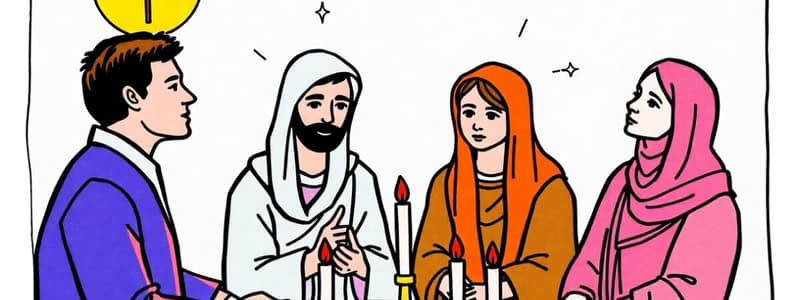Podcast
Questions and Answers
How does religion function as a mechanism of adjustment for individuals facing life's challenges?
How does religion function as a mechanism of adjustment for individuals facing life's challenges?
Religion provides comfort and a sense of purpose to individuals, helping them cope with life's difficulties.
Define civil religion as introduced by Robert Bellah.
Define civil religion as introduced by Robert Bellah.
Civil religion refers to the set of beliefs, symbols, and rituals that provide a religious dimension to the life of a nation.
What is Clifford Geertz’s perspective on religion's role in culture?
What is Clifford Geertz’s perspective on religion's role in culture?
Geertz views religion as a cultural system that provides meaning and guides social behavior.
What role does totemism play in Durkheim's understanding of collective conscience?
What role does totemism play in Durkheim's understanding of collective conscience?
How does Malinowski argue that religion provides psychological functions during life crises?
How does Malinowski argue that religion provides psychological functions during life crises?
Study Notes
Religion and Individual Adjustment
- Religion provides comfort and support during challenging life events.
- Religious beliefs can offer meaning and purpose, helping individuals cope with hardship.
- Rituals and practices provide structure and routine, offering a sense of control and stability.
- Faith communities provide social networks and a sense of belonging, mitigating feelings of isolation.
Parsons' View on Universal Values
- Parsons argues that core religious values like love, compassion, and forgiveness contribute to societal stability.
- Critics argue that this view ignores the diversity of religious beliefs and practices, and how they can sometimes contribute to conflict.
Civil Religion
- Robert Bellah defines civil religion as a secularized religious belief system shared by a society.
- It draws on religious symbols and language but doesn't require adherence to specific religious doctrines.
Manifestations of American Civil Religion
- Bellah identifies American civil religion in national holidays, patriotic symbols, and political rhetoric.
- Examples include the Pledge of Allegiance, the Statue of Liberty, and the "American Dream."
Geertz's Perspective on Religion
- Clifford Geertz views religion as a system of cultural symbols that provide meaning and order to life.
- He emphasizes the role of shared beliefs and practices in shaping a cultural worldview.
Dual Role of Religion in Shaping Reality
- Religion creates both a "model of reality" and a "model for reality" according to Geertz.
- The "model of reality" provides answers to questions about existence, while the "model for reality" guides behavior and moral actions.
Religion and Social Change
- Max Weber argued that religion can be a catalyst for social change.
- He saw the Protestant work ethic as contributing to the rise of capitalism.
Criticism of Geertz
- Geertz's emphasis on the "meaning-making" function of religion overlooks the role of power in shaping religious beliefs and practices.
- This neglects the ways religion is often used to justify social inequalities or control individuals' actions.
The Sacred and the Profane
- Durkheim distinguishes between the sacred, which inspires awe and reverence, and the profane, which is ordinary and mundane.
- This distinction is crucial for understanding how religion shapes collective identity and strengthens social bonds.
Totemism and Collective Conscience
- Totemism represents the collective conscience or shared beliefs and values of a society.
- It symbolizes the sacredness of the group and strengthens group solidarity.
Malinowski's Psychological Functions of Religion
- Religion provides psychological support and emotional comfort during times of stress and uncertainty.
- It offers mechanisms for coping with life crises, including birth, death, illness, and societal transitions.
Trobriand Islanders and Fishing Rituals
- Malinowski observed that the Trobriand Islanders engaged in rituals before and after fishing trips.
- These rituals weren't about influencing natural outcomes but about achieving psychological stability and reaffirming their faith.
Parsons' View of Religion and Social Order
- Parsons argues that religion provides a moral framework for society, promoting social order and stability.
- Religious values contribute to shared norms, expectations, and beliefs that guide behavior.
Criticisms of Durkheim
- Critics argue that Durkheim's focus on the social functions of religion neglects the individual experiences of faith.
- His theory also struggles to account for the diversity of religious beliefs and practices across cultures.
Malinowski's Contrasting View
- Malinowski's view contrasts with the idea that religion always leads to social harmony and stability.
- His work emphasizes the psychological functions of religion, particularly during times of stress and uncertainty.
Collective Effervescence and Social Solidarity
- "Collective effervescence" refers to a state of heightened emotional intensity experienced during religious gatherings and rituals.
- Durkheim argues that this shared experience strengthens social solidarity by reaffirming collective identity and shared beliefs.
Studying That Suits You
Use AI to generate personalized quizzes and flashcards to suit your learning preferences.
Related Documents
Description
Explore how religion influences individual well-being and societal values. This quiz delves into the role of religious beliefs, civil religion, and universal values in coping with life's challenges and contributing to social stability.



